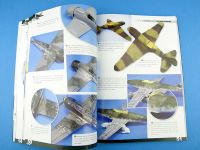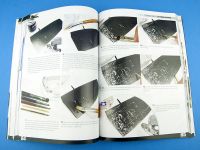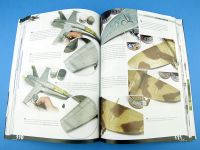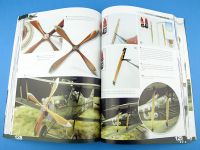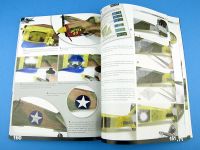AMMO of Mig Jimenez | Encyclopedia of Aircraft Modelling Techniques Volume 3: Painting
Reviewed by Kevin Futter
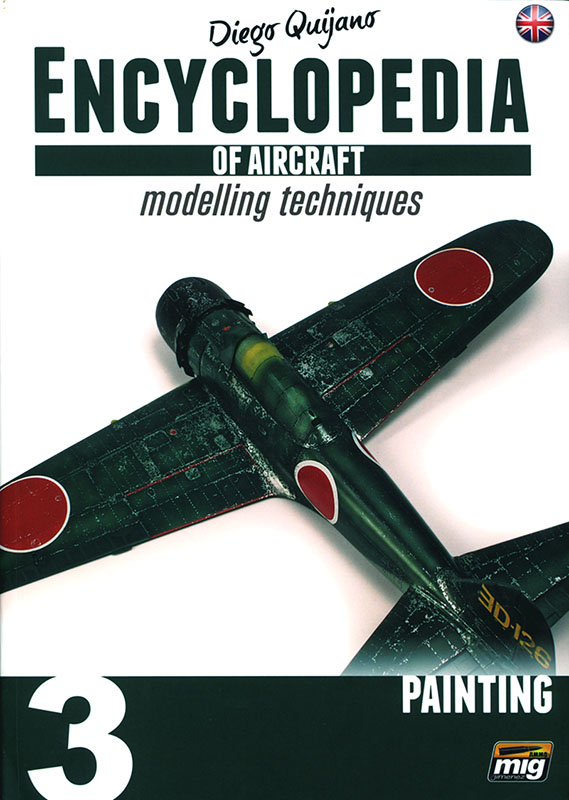
Spanish firm AMMO of Mig Jimenez specialises in finishing products for scale models, and also publishes The Weathering Magazine. The company's publishing endeavours have now been expanded with the release of Volume 3 in an ambitious series entitled Encyclopedia of Aircraft Modelling Techniques. The series is authored by well-known Spanish modeller Diego Quijano, with five volumes planned in all. Volume 3 focusses on exterior painting.
This title weighs in at 199 pages, and despite its Spanish provenance, the text is in English throughout (it's also available in Spanish). While the number of typos and expression errors continues to improve compared with the earlier volumes, there are a couple of unfortunate clangers that suggest more work still needs to be done. For example, on page 140, the caption labelled 32/33 has been left in the original Spanish, having failed to be translated into English. Elsewhere, on page 166, the number sequence for the photos runs out-of-order, being 38, 29, 47, 41 ... (the sequence should be 38, 39, 40, 41, which matches the accompanying captions).
These are relatively minor problems, of course, but I'd still like to see further improvements in this area for the final two volumes.
The content itself is presented as a series of magazine-style photo-essays, and is broken up into two main sections, each with nine sub-sections (note that the section numbering continues from Vol. 2):
- 5.1 Preparations and Priming
- 5.2 Pre-shading
- 5.3 Base Coat and Monotone Camouflage Patterns
- 5.4 Multi-tone Camouflage Schemes
- 5.5 Chipped Camouflages
- 5.6 Airbrush Highlights and Fading
- 5.7 Wood
- 5.8 Insignia, Numerals and Stencils
- 5.9 Shading with Inks
The following is a brief overview of each section.
5.1 Preparations and Priming
This chapter is pretty much self-explanatory, with tips and advice on surface preparation and cleaning, as well as the use of primers before painting. I do take issue with the following comment, however (page 9):
A gloss black primer must be used for metal colors.
Personally I think this is a little misleading, and really only applies to the Alclad High Shine varieties in my experience. When using standard metallic paints such as those from Humbrol, Tamiya, or AK Interactive, I've found laying down a black base offers no particular advantage.
5.2 Pre-shading
Pre-shading has become a topic of some controversy in recent times, but no treatise on finishing techniques would be complete without covering it. This chapter does so quite comprehensively, examining no less than six different approaches to the task, from the classical method of spraying the panels with dark paint, to modulation effects and pre-coloured panels. While some of the effects shown tend toward the heavy-handed end of the spectrum, there's no reason they can't be moderated to taste, or simply avoided altogether.
5.3 Base Coat and Monotone Camouflage Patterns
This chapter deals with getting the first layer of camouflage colours onto the model, and is predicated on the notion that pre-shading has been employed. Still, the advice about paint dilution, airbrush technique, and general approach to painting, is all valuable, irrespective of the use of pre-shading.
Also covered in this section are glossy finishes and metal finishes. The latter contains some particularly useful information about achieving multi-panel effects, and varying the resultant finish with post-shading. The featured builds are quite striking!
5.4 Multi-tone Camouflage Schemes
Multi-coloured aircraft finishes are of course much more common that single-colour ones, and this chapter tackles the challenges inherent in painting such schemes. Various masking methods are explored to achieve different types of colour demarcations, along with freehand airbrushing and mottling. Once again, this section is full of great advice regarding things such as airbrush technique, the need to plan a mottle pattern (rather than just improvising it), effective masking techniques, etc.
One of the notions that works its way through this volume is that of using modulation effects to create a sense of volume and contrast on the model. I have to confess that I'm not a fan of this approach, as it introduces quite an artificial look to the model. In fact, the basic premise of the technique is drawn from the world of 2-dimensional art, where there is a need to represent a flat, 2-dimensional object on paper or canvas, as having three dimensions. Scale models are physical objects that already possess three dimensions, and exaggerating their dimensional characteristics through painting effects seems completely redundant to me. That being said, if you'd like to experiment with this approach, it's detailed quite thoroughly throughout this book.
5.5 Chipped Camouflages
While paint chipping is rightfully considered a weathering technique (the subject of weathering is dealt with in Volume 4 of the series), many of the common approaches for representing it need to be factored into the basic painting stages of the model. Thus, this chapter details these methods. The primary approach shown utilises so-called 'chipping fluids' to allow the camouflage colours to be chipped off, revealing the silver base coat.
Also given extensive coverage are the techniques used to achieve a heavily-weathered winter camouflage effect. Using sponges and sanding sticks to distress the finish are two particularly useful tips.
5.6 Airbrush Highlights and Fading
The aim of this chapter is to show various techniques for achieving a multi-hued finish to the camouflage. The focus is mainly divided between lightening and darkening panels, and modulation. Some of the results on show are not to my tastes at all, lacking subtlety and authenticity. The author does acknowledge, however, that many of the techniques shown are designed to produce an artistic result, rather than a strictly realistic one.
As ever, the reader is free to moderate, modify, or even ignore the approaches being shown in this chapter.
5.7 Wood
I found this the most interesting chapter in the book. It's full of great tips and techniques that I hadn't seen before, and the featured results present a level of realism and verisimilitude that isn't always evident in other sections of the book. The use of both paint and decals is covered, and the results are highly inspirational.
5.8 Insignia, Numerals and Stencils
This chapter is divided into three main sections, dealing with decals, dry transfers, and paint masks. Once again, there are many great tips here, and the discussion about decals made me lament my own shoddy approach to them. The author also does his best to show you how to make dry transfers usable in scale modelling, but I suspect most LSP modellers will find the section on paint masks the most valuable. Not only are commercial sets covered, but so are the techniques involved in making and using your own. This is done with readily available modelling tools, rather than requiring a cutting plotter. There's even a section on reproducing stencils with markers and paint. All in all, a very useful and enlightening chapter.
5.9 Shading with Inks
The final chapter of the book takes a look at enhancing structural elements using shading. While the chapter title uses the word inks, most of the featured examples use a tinted acrylic, such as Tamiya's Smoke. These translucent paints are used to great effect to highlight fabric-covered ribs, puttied panel lines, and other structural elements. This can add a great deal of visual interest to a model, but as ever, must be used judiciously, as it is easily overdone!
Sample Pages
Below is a random selection of pages from the book, to give you a feel for the content and presentation.
Conclusion
This series is an ambitious undertaking, and Volume 3 is probably the most prescriptive of the series so far. Painting scale model aircraft is subject to personal tastes and preferences in a way that their construction is not. This volume has a heavy emphasis on the type of paint effects that have come to be known as the Spanish School - unsurprising given the Spanish origins of both author and publisher. As I've noted elsewhere in the text, I found these stylised effects overdone in places, and not to my tastes at all. But this in no way detracts from the usefulness of the information conveyed, or the validity of the approaches themselves. Most of what is presented here is eminently adaptable to a wide variety of tastes and approaches. There are hints and tips here aplenty, and something to learn or be inspired by, no matter your current level of modelling skills. Highly recommended!
Thanks to AMMO of Mig Jimenez for the review sample.
© Kevin Futter 2015
This review was published on Sunday, December 20 2015; Last modified on Monday, December 21 2015

